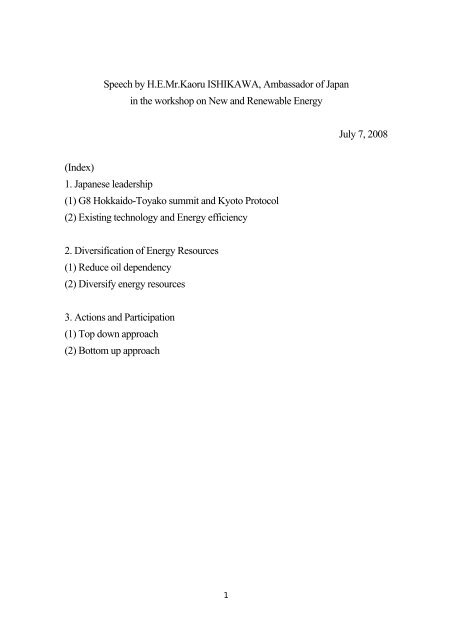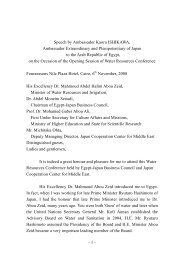Speech by Ambassador(PDF) - Embassy of Japan in Egypt
Speech by Ambassador(PDF) - Embassy of Japan in Egypt
Speech by Ambassador(PDF) - Embassy of Japan in Egypt
Create successful ePaper yourself
Turn your PDF publications into a flip-book with our unique Google optimized e-Paper software.
<strong>Speech</strong> <strong>by</strong> H.E.Mr.Kaoru ISHIKAWA, <strong>Ambassador</strong> <strong>of</strong> <strong>Japan</strong><br />
<strong>in</strong> the workshop on New and Renewable Energy<br />
July 7, 2008<br />
(Index)<br />
1. <strong>Japan</strong>ese leadership<br />
(1) G8 Hokkaido-Toyako summit and Kyoto Protocol<br />
(2) Exist<strong>in</strong>g technology and Energy efficiency<br />
2. Diversification <strong>of</strong> Energy Resources<br />
(1) Reduce oil dependency<br />
(2) Diversify energy resources<br />
3. Actions and Participation<br />
(1) Top down approach<br />
(2) Bottom up approach<br />
1
H.E. M<strong>in</strong>ister <strong>of</strong> Higher Education, Dr. Hany Mahfouz Helal,<br />
H.E. M<strong>in</strong>ister <strong>of</strong> Electricity, Eng. Hassan Ahmed Younes<br />
Dist<strong>in</strong>guished Guests,<br />
Ladies and Gentlemen,<br />
1. <strong>Japan</strong>ese Leadership<br />
(1) G8 Hokkaido-Toyako summit and Kyoto Protocol<br />
July the 7 th is an important day for us <strong>Japan</strong>ese, s<strong>in</strong>ce we believe that this is the<br />
only even<strong>in</strong>g throughout the year that two lovers separated across the Milky Way<br />
could meet. And that, with one important condition: if the sky is not clean, they<br />
cannot meet. I believe that this is the reason why my Prime M<strong>in</strong>ister<br />
H.E.Mr.Yasuo Fukuda decided to host G8 Summit today <strong>in</strong> <strong>Japan</strong>ese Northern<br />
Island <strong>of</strong> Hokkaido, to discuss how to keep clear the sky.<br />
Well, joke put aside, 2008 is the first year <strong>of</strong> Kyoto Protocol, and we must talk<br />
seriously and take concrete actions for post-2012 framework on climate change<br />
after the first commitment period <strong>of</strong> Kyoto Protocol. In 2005, G8 Gleneagles<br />
Summit was held <strong>in</strong> Scotland, and described <strong>in</strong> details eco-friendly energy<br />
actions to be taken <strong>by</strong> G8 countries <strong>in</strong> various sectors such as construction,<br />
appliances, surface transport, aviation and <strong>in</strong>dustry. G8 leaders also committed<br />
themselves to promote the cont<strong>in</strong>ued development and commercialization <strong>of</strong><br />
renewable energy.<br />
Last year, <strong>Japan</strong> proposed the “Cool Earth 50” promotion program, call<strong>in</strong>g for<br />
a halv<strong>in</strong>g <strong>of</strong> global greenhouse gas emissions <strong>by</strong> 2050. At the annual World<br />
Economic Forum held <strong>in</strong> Davos <strong>in</strong> January 2008, Prime M<strong>in</strong>ister Fukuda<br />
outl<strong>in</strong>ed his new proposal “Cool Earth Promotion Programs”, and emphasized<br />
equity <strong>in</strong> the target sett<strong>in</strong>g for the post-Kyoto framework, while <strong>of</strong>fer<strong>in</strong>g <strong>Japan</strong>’s<br />
<strong>in</strong>ternational cooperation <strong>in</strong> adaptation and mitigation <strong>of</strong> the climate change.<br />
<strong>Japan</strong> believes it necessary to establish quantified national targets for emissions<br />
reductions, and to realize these targets a bottom-up approach is a logical<br />
2
conclusion. That is to compile a sectoral basis energy efficiency and tally<strong>in</strong>g up<br />
the reduction volume.<br />
Year 2008 co<strong>in</strong>cides with the start<strong>in</strong>g year <strong>of</strong> Kyoto Protocol commitment. To<br />
realize our common goal, huge energy consum<strong>in</strong>g and CO2 emitt<strong>in</strong>g countries<br />
such as USA and Ch<strong>in</strong>a are encouraged to jo<strong>in</strong> other countries’ endeavor. In<br />
do<strong>in</strong>g so, not only new technology but also exist<strong>in</strong>g technology will play a key<br />
role. We need to implement concrete application <strong>of</strong> new and exist<strong>in</strong>g<br />
technologies to actual factories’ production system and their products, and each<br />
<strong>of</strong> us must change consumers’ purchase preferences and to change our life style.<br />
<strong>Japan</strong> <strong>in</strong>tends to help develop<strong>in</strong>g countries <strong>in</strong> their concrete actions not only to<br />
adapt to, but also and ma<strong>in</strong>ly to mitigate climate change through f<strong>in</strong>ancial as well<br />
as technical cooperation. This will ensure that develop<strong>in</strong>g countries will realize a<br />
new way <strong>of</strong> economic take <strong>of</strong>f, without h<strong>in</strong>der<strong>in</strong>g their people’s health. Indeed,<br />
<strong>Japan</strong> is eager to support develop<strong>in</strong>g countries, because with today’s technology<br />
they can avoid repeat<strong>in</strong>g our mistakes caus<strong>in</strong>g death and health hazard to the<br />
people only if they so decide.<br />
(2) Exist<strong>in</strong>g technology and Energy Efficiency<br />
Based on this conviction and the high level <strong>in</strong> energy efficiency and <strong>in</strong> energy<br />
diversification, both <strong>of</strong> which are based on technology, <strong>Japan</strong> is extend<strong>in</strong>g<br />
transfer <strong>of</strong> technology to develop<strong>in</strong>g countries. There are two concrete merits.<br />
Firstly, if you use less energy resources to produce same amount <strong>of</strong> GDP, it<br />
means that you contribute not only to energy conservation but also to emit less<br />
CO2, SOx and NOx. Secondly, world can benefit the world highest exist<strong>in</strong>g<br />
technology. In fact, accord<strong>in</strong>g to International Energy Agency, or IEA, <strong>Japan</strong> has<br />
the highest energy efficiency <strong>in</strong> the world. To produce a same amount <strong>of</strong> GDP,<br />
<strong>Japan</strong> uses half <strong>of</strong> the energy that USA uses, one tenth <strong>of</strong> Ch<strong>in</strong>a and India, and<br />
one twentieth <strong>of</strong> Russia. This is because <strong>Japan</strong> has been extend<strong>in</strong>g strenuous<br />
efforts to realize energy-efficient society while some others did not. If others<br />
<strong>in</strong>troduce similar measures, the earth will be less polluted and energy will be<br />
3
preserved as well.<br />
(Note: To produce 1000 US Dollars GDP, <strong>Japan</strong> needs 0.106 tons oil equivalent<br />
energy, USA needs 0.221, both Ch<strong>in</strong>a and India need 1.020 and Russia needs<br />
2.090. This means that USA uses 2.1 times more energy resources than <strong>Japan</strong> to<br />
produce the same amount <strong>of</strong> wealth, Ch<strong>in</strong>a and India 9.6 times and Russia 19.7<br />
times. World average is 3.0 times. )<br />
Here, I must stress one important po<strong>in</strong>t. That is, before talk<strong>in</strong>g about new<br />
energy resources, we must know that with already exist<strong>in</strong>g technologies on earth,<br />
we can do much better, only if people concerned want to use them. Some really<br />
do not want to. So, actually <strong>by</strong> implement<strong>in</strong>g concrete actions <strong>in</strong> countries such<br />
as Ch<strong>in</strong>a and India with our help, they can largely improve their energy<br />
efficiency. Our support to these countries is usually extended through <strong>of</strong>ficial<br />
development assistance, or ODA. But <strong>in</strong> addition to that, private bus<strong>in</strong>ess is also<br />
do<strong>in</strong>g well <strong>in</strong> renewable energy sector. For example, <strong>in</strong> India, a <strong>Japan</strong>ese<br />
company established a jo<strong>in</strong>t venture with a small yet dynamic newly established<br />
Indian entrepreneurial company, and they sell together small scale w<strong>in</strong>dmill<br />
generator to ord<strong>in</strong>ary households <strong>in</strong> Indian rural area. Incidentally here <strong>in</strong> <strong>Egypt</strong>,<br />
<strong>Japan</strong> Bank for International Cooperation supports w<strong>in</strong>d power generation<br />
project <strong>in</strong> Zafarana on Red Sea region (the amount is 13.5 billion yen / about 110<br />
million US Dollars. S<strong>of</strong>t loan with 10 years grace period and 30 years repayment<br />
with 0.75% <strong>in</strong>terest rate). I may also mention that some European countries<br />
ignore the fact that cyclone, monsoon or typhoon exists on other part <strong>of</strong> the world<br />
and it is only <strong>in</strong> Europe that they have mild and constant breeze. This ignorance is<br />
h<strong>in</strong>der<strong>in</strong>g wider use <strong>of</strong> w<strong>in</strong>d power <strong>in</strong> the world.<br />
(Ladies and Gentlemen,)<br />
2. Diversification <strong>of</strong> Energy Resources<br />
(1) Reduce oil dependency<br />
I come from a country which has no natural resources. This is an important<br />
po<strong>in</strong>t when I speak about energy and energy efficiency. Indeed, if you do not<br />
4
have natural resources, logical conclusion would lead you to diversify your<br />
supply sources, to use the obta<strong>in</strong>ed resources <strong>in</strong> the most efficient way and to<br />
<strong>in</strong>novate technology to get energy resources from new materials <strong>in</strong>clud<strong>in</strong>g<br />
sunsh<strong>in</strong>e and w<strong>in</strong>d which are limitless. The world has learned very expensive<br />
lessons through the two oil crises <strong>in</strong> the last century, but <strong>Japan</strong> alone took it really<br />
seriously and started to reduce the high dependency on oil. One <strong>of</strong> the results <strong>of</strong><br />
this strategy is clearly shown <strong>in</strong> electricity sector. In 1973 the share <strong>of</strong> oil <strong>in</strong><br />
<strong>Japan</strong>ese power generation was 71.4%. It went down through the years and <strong>in</strong><br />
year 2004, the share was 8.2%. Dur<strong>in</strong>g the 31years, nuclear energy and LNG<br />
<strong>in</strong>creased their share and, <strong>in</strong> 2004 they were 29% and 26% respectively. We are<br />
pursu<strong>in</strong>g actions to realize the best energy mix. In case <strong>of</strong> power generation, it<br />
would be to use hydropower, geothermal, nuclear, coal, LNG and oil accord<strong>in</strong>g<br />
to electricity demand pattern.<br />
(2) Diversify energy resources<br />
Another challenge that all <strong>of</strong> us are now fac<strong>in</strong>g is climate change. This leads us<br />
to accelerate technology <strong>in</strong>novation to further diversify energy resources and<br />
enhance energy efficiency. In case <strong>of</strong> electricity generation, <strong>Japan</strong> has<br />
comparative advantage ma<strong>in</strong>ly <strong>in</strong> the follow<strong>in</strong>g technologies.<br />
(i) 55% <strong>of</strong> world photovoltaic power generation is now produced <strong>in</strong> <strong>Japan</strong><br />
(source: IEA). Our target for year 2010 is to generate 4 million 820 thousand<br />
kilowatt. We will dramatically raise the generation efficiency. And we will<br />
reduce the current cost <strong>of</strong> solar power generation (46 yen/kWh) to the same level<br />
as thermal generation (7 yen/kWh). In addition to traditional photovoltaic<br />
generation devices, some private companies have <strong>in</strong>vented transparent solar<br />
battery. This battery has a shape <strong>of</strong> usual grass w<strong>in</strong>dow which allows sunlight to<br />
go through the w<strong>in</strong>dow. Big difference with usual w<strong>in</strong>dow is that it generates<br />
electricity.<br />
5
(ii) W<strong>in</strong>d power generation is also a high priority. The problem <strong>of</strong> countries<br />
which are situated <strong>in</strong> east side <strong>of</strong> a cont<strong>in</strong>ent like <strong>Japan</strong> is that we do not have<br />
constant breeze but face typhoon or calm (that means no w<strong>in</strong>d). This led some<br />
<strong>Japan</strong>ese private companies to <strong>in</strong>vent small size w<strong>in</strong>d mill which generate power<br />
with very weak w<strong>in</strong>d. The size is so handy that <strong>in</strong>stead <strong>of</strong> <strong>in</strong>stall<strong>in</strong>g huge w<strong>in</strong>d<br />
mills <strong>in</strong> the midst <strong>of</strong> nowhere, each household can afford <strong>in</strong>stall<strong>in</strong>g a small<br />
w<strong>in</strong>dmill to suffice its need. Hybrid type <strong>of</strong> solar and w<strong>in</strong>d power generation<br />
devices are also available.<br />
(iii) Light-emitt<strong>in</strong>g diode, or LED, is also a new trump card. LED needs little<br />
electricity to produce large light energy. You can see them ma<strong>in</strong>ly used so far <strong>in</strong><br />
traffic light and publicity panels. In <strong>Japan</strong>ese rural areas, traffic lights with LED<br />
are <strong>of</strong>ten powered <strong>by</strong> a small solar panel. Good news is that LED has also started<br />
to be used as light<strong>in</strong>g <strong>in</strong> <strong>of</strong>fice and house.<br />
(iv) We have also rediscovered hydroelectric power generation <strong>in</strong> the sense that<br />
small to medium scale hydropower generation is now ma<strong>in</strong>streamed. If you have<br />
a small stream <strong>in</strong> your backyard you can get electricity. A village <strong>of</strong> 1500<br />
households with four persons each can obta<strong>in</strong> necessary electricity <strong>by</strong> a s<strong>in</strong>gle<br />
4500 kilowatt generator.<br />
Regard<strong>in</strong>g transportation sector, needless to say hybrid car is rapidly <strong>in</strong>creas<strong>in</strong>g<br />
its market share. For example, TOYOTA, the lead<strong>in</strong>g producer <strong>of</strong> hybrid cars,<br />
has produced more than half a million Prius, lead<strong>in</strong>g hybrid car. Incidentally,<br />
<strong>Japan</strong>ese Prime M<strong>in</strong>ister’s car is a hybrid LEXUS. Talk<strong>in</strong>g about Government<br />
<strong>of</strong>ficial cars, under the direct <strong>in</strong>struction <strong>of</strong> then Prime M<strong>in</strong>ister Mr. Junichiro<br />
Koizumi, all <strong>of</strong> the 7,000 cars owned <strong>by</strong> <strong>Japan</strong>ese central government are<br />
replaced <strong>by</strong> eco-friendly cars such as hybrid cars and LNG fuel cars.<br />
3. Actions and Participation<br />
(1) Top down approach<br />
6
To further enhance the use <strong>of</strong> new energy, we need political leadership, legal<br />
framework and people’s participation, not to mention world wide participation to<br />
build a better future.<br />
Let me first illustrate some concrete cases <strong>of</strong> top down approach. In <strong>Japan</strong>,<br />
successive Prime M<strong>in</strong>isters have been tak<strong>in</strong>g lead<strong>in</strong>g roles to realize a less energy<br />
consum<strong>in</strong>g society with emphasis on energy efficiency, diversification <strong>of</strong> energy<br />
resources and change <strong>of</strong> life style.<br />
For example, ten years ago, Prime M<strong>in</strong>ister Hashimoto, while cutt<strong>in</strong>g <strong>by</strong> half<br />
the number <strong>of</strong> <strong>Japan</strong>ese M<strong>in</strong>istries to pursue adm<strong>in</strong>istrative reform, graded up<br />
National Environment Agency to Environment M<strong>in</strong>istry.<br />
Prime M<strong>in</strong>ister Koizumi ordered to change all <strong>of</strong> the government owned cars<br />
to eco-friendly vehicles as I mentioned earlier, and <strong>in</strong>troduced solar generation<br />
system to all <strong>of</strong> the m<strong>in</strong>istries’ build<strong>in</strong>gs, <strong>in</strong>clud<strong>in</strong>g Prime M<strong>in</strong>ister’s <strong>of</strong>fice. The<br />
Prime M<strong>in</strong>ister’s <strong>of</strong>fice is also equipped with the first model <strong>of</strong> fuel battery for<br />
hous<strong>in</strong>g. Prime M<strong>in</strong>ister Abe, who came to Cairo, last year, declared that his<br />
adm<strong>in</strong>istration will implement measures to tackle with the global warm<strong>in</strong>g<br />
<strong>in</strong>clud<strong>in</strong>g the promotion <strong>of</strong> the use <strong>of</strong> renewable energies. And as I have<br />
mentioned earlier today, Prime M<strong>in</strong>ister Fukuda proposed “Cool Earth<br />
Partnership Program,” and is now lead<strong>in</strong>g Discussion on climate change <strong>in</strong> the<br />
G8 Hokkaido Toyako meet<strong>in</strong>g.<br />
In these campaigns to promote energy efficiency and energy resources<br />
diversification, people’s life style is not a sanctuary. The Koizumi adm<strong>in</strong>istration<br />
fixed air condition<strong>in</strong>g temperature <strong>in</strong> public build<strong>in</strong>gs at 28 degrees and not less<br />
dur<strong>in</strong>g the hot summer season. At the same time Prime M<strong>in</strong>ister himself took <strong>of</strong>f<br />
his tie dur<strong>in</strong>g the summer season so that the warm air-condition<strong>in</strong>g could be<br />
accepted <strong>by</strong> people. Incidentally, this triggered a new fashion <strong>in</strong> <strong>Japan</strong> and<br />
boosted textile and cloth <strong>in</strong>dustry. The adm<strong>in</strong>istration also launched a campaign<br />
to change the m<strong>in</strong>d set <strong>of</strong> people to th<strong>in</strong>k more seriously about the resources. The<br />
campaign is ‘Reduce waste, Reuse resources and Recycle goods’. This campaign<br />
was named ‘3R’ campaign. We see some plastic bottles conta<strong>in</strong><strong>in</strong>g water on the<br />
7
table. In <strong>Japan</strong> they are recycled after use for the production <strong>of</strong> clothes. Here lies<br />
a h<strong>in</strong>t. Renewable energy can be promoted as a part <strong>of</strong> holistic approach. In my<br />
humble op<strong>in</strong>ion, just promot<strong>in</strong>g renewable energy <strong>by</strong> s<strong>in</strong>gl<strong>in</strong>g it out would not<br />
necessarily lead to a massive and effective move towards the actual use <strong>of</strong><br />
renewable energies.<br />
In a broader front, rule mak<strong>in</strong>g is also a result oriented approach. In my<br />
country, electricity companies are legally bound to use a certa<strong>in</strong> percentage <strong>of</strong><br />
w<strong>in</strong>d energy, solar energy, geothermal energy, medium and small scale<br />
hydropower generation and biomass to generate electricity.<br />
(2) Bottom up approach<br />
Now, we can not talk about holistic approach without mention<strong>in</strong>g ord<strong>in</strong>ary<br />
citizen’s participation. The above mentioned ‘3R’ campaign, ‘Reduce, Reuse and<br />
Recycle campaign’ was certa<strong>in</strong>ly launched <strong>by</strong> the then Prime M<strong>in</strong>ister, but it<br />
would not have spread at national level unless ord<strong>in</strong>ary people supported it and<br />
participated <strong>in</strong> the movement.<br />
People’s participation is more clearly recognized <strong>in</strong> my country <strong>in</strong> solar panel<br />
and w<strong>in</strong>d power generation. Many households have their solar panel on the ro<strong>of</strong><br />
which generates electricity for the household’s use which contributes not only to<br />
reduce the use <strong>of</strong> traditional energy resources but also to reduce household’s<br />
spend<strong>in</strong>g. Some construct<strong>in</strong>g companies have put <strong>in</strong>to market ro<strong>of</strong> which are<br />
themselves solar panels. Small scale w<strong>in</strong>dmill generator is also ga<strong>in</strong><strong>in</strong>g little <strong>by</strong><br />
little ord<strong>in</strong>ary household’s support. When they generate more electricity than the<br />
consumption <strong>by</strong> the household, the household can sell the electricity to electricity<br />
companies. Participation is also encouraged through market mechanism. For<br />
example, we have a campaign named ‘top runner method’. When an appliance or<br />
a car is recognized as the most energy efficient <strong>by</strong> a neutral <strong>in</strong>dependent<br />
commission, the said appliance maker or car producer is <strong>of</strong>ficially allowed to say<br />
so publicly <strong>in</strong> the market. This gives them more attractive feature to consumers.<br />
Market mechanism, through competition, will then force other producers to<br />
8
improve their energy efficiency through new technology renovation <strong>in</strong>clud<strong>in</strong>g the<br />
use <strong>of</strong> new energy resources. Label<strong>in</strong>g is also an efficient way to heighten<br />
consumer’s <strong>in</strong>terest to those products which have <strong>of</strong>ficial label show<strong>in</strong>g that they<br />
are eco-friendly. In those cases, both producers and consumers participate <strong>in</strong><br />
improv<strong>in</strong>g energy efficiency and energy resources diversification.<br />
In conclusion, let me reiterate three po<strong>in</strong>ts that I believe important <strong>in</strong><br />
promot<strong>in</strong>g renewable energies.<br />
One: top down approach with strong political will<br />
Two: solid technology basis <strong>in</strong>clud<strong>in</strong>g shar<strong>in</strong>g <strong>of</strong> knowledge and transfer <strong>of</strong><br />
technology, and<br />
Three: bottom up approach through participation <strong>of</strong> market players and ord<strong>in</strong>ary<br />
citizens<br />
Today my country has the highest technology to prevent pollution. Under the<br />
strong leadership <strong>of</strong> Prime M<strong>in</strong>ister Yasuo Fukuda, we are launch<strong>in</strong>g COOL<br />
EARTH INTIATIVES. Develop<strong>in</strong>g countries which support COOL EARTH<br />
INTIATIVES and also implement concrete actions to fight back environmental<br />
degradation are eligible to our technical cooperation; Prime M<strong>in</strong>ister Fukuda set a<br />
new fund amount<strong>in</strong>g approximately to 10 billion dollars for this purpose.<br />
I thank you for your k<strong>in</strong>d attention.<br />
9








